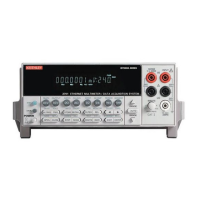3-24 Basic DMM Operation Model 2701 User’s Manual
Offset-compensated ohms
The presence of thermal EMFs (V
EMF
) can adversely affect low-resistance measurement
accuracy. To overcome these unwanted offset voltages, you can use offset-compensated
ohms (OCOMP). Offset-compensated ohms measurements can be performed on the 100Ω,
1kΩ, and 10kΩ ranges for the Ω4 function. It cannot be done on the Ω2 function.
NOTE The various instrument operations, including OCOMP, are performed on the
input signal in a sequential manner. See “Signal processing sequence,”
page D-2 for details. It includes a flowchart showing where in the processing
sequence that the OCOMP operation is performed.
For a normal resistance measurement, the Model 2701 sources a current (I) and measures
the voltage (V). The resistance (R) is then calculated (R=V/I) and the reading is displayed.
For offset-compensated ohms, two measurements are performed: one normal resistance
measurement and one using the lowest current source setting.
The offset-compensated ohms reading is then calculated as follows:
Offset-compensated ohms reading = ∆V/∆I
where: ∆V = V2 - V1
∆I = I2 - I1
V1 is the voltage measurement with the current source at its normal level.
V2 is the voltage measurement using the lowest current source setting.
The above 2-point measurement process and reading calculation eliminates the resistance
contributed by the presence of V
EMF
.
Enabling/disabling offset-compensated ohms
Offset-compensated ohms is enabled by pressing SHIFT and then OCOMP. When
enabled, the OCOMP annunciator is on. Offset-compensated ohms is disabled by again
pressing SHIFT and then OCOMP.

